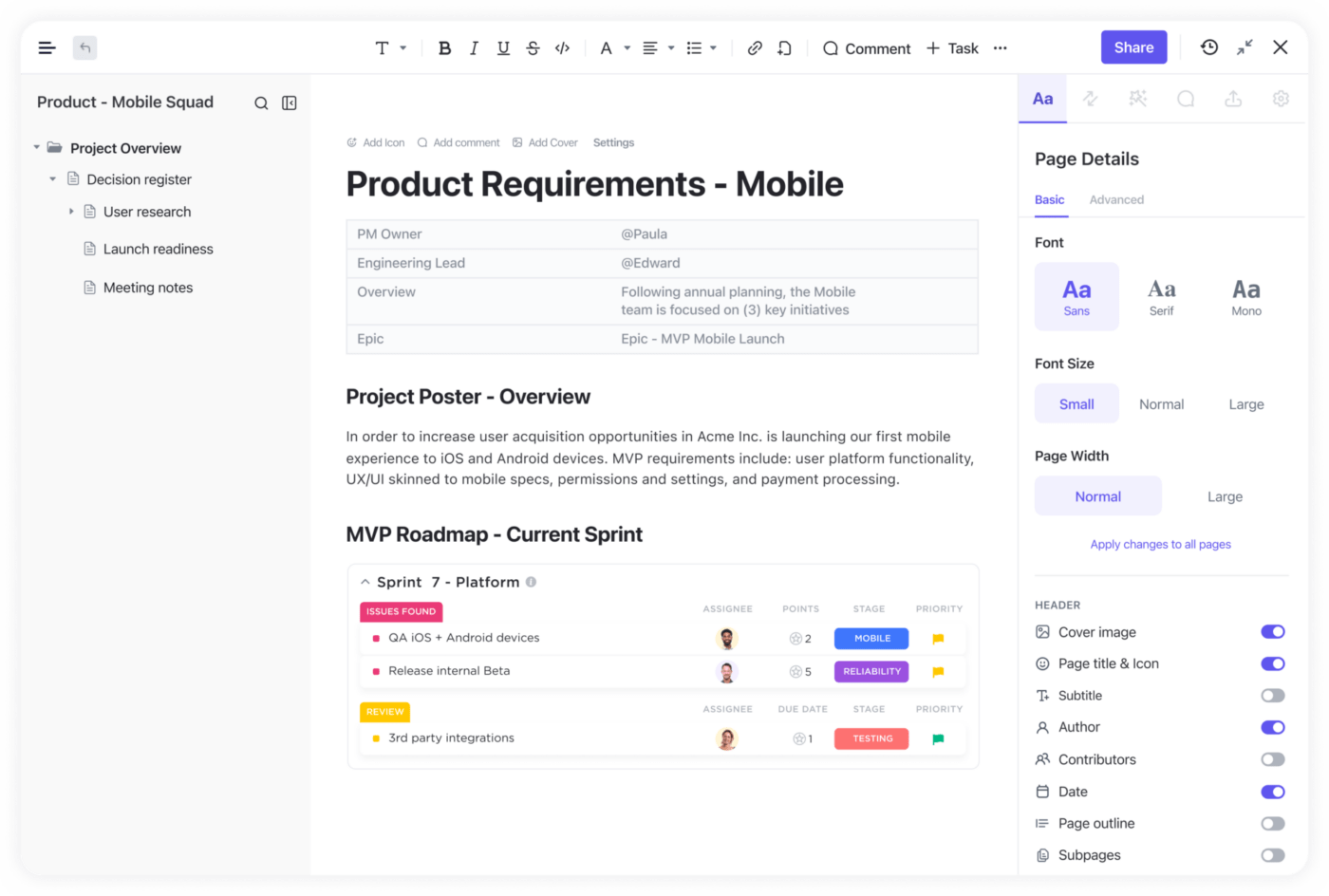يتحمل مدير المشروع مسؤولية التحقق من صحة متطلبات المشروع وتوثيقها وتحديد أولوياتها. هذه المهام أساسية لنجاح المشروع، ولكنها تأتي مع مجموعة من التحديات.
فالعديد من المشاريع الحديثة هي جزء من منظومات أو برامج أكبر، حيث يعتمد نجاحها على التنسيق بين عدة مشاريع مترابطة. يصبح تحديد المتطلبات معقدًا لأنه ينطوي على مواءمة الأهداف عبر مبادرات مختلفة, إدارة التبعيات والحفاظ على بنية مشروع جيدة التنسيق.
في هذا الدليل، سنستعرض الاستراتيجيات والأدوات والتقنيات اللازمة للكشف عن الهدف الحقيقي وراء المشروع المطلوب وكيفية ترجمته إلى فريق المشروع. 🌐
قم بتحميل نموذج متطلبات إدارة مشروع ClickUp لإدارة المشاريع للمتابعة والبدء في تنظيم مهامك!
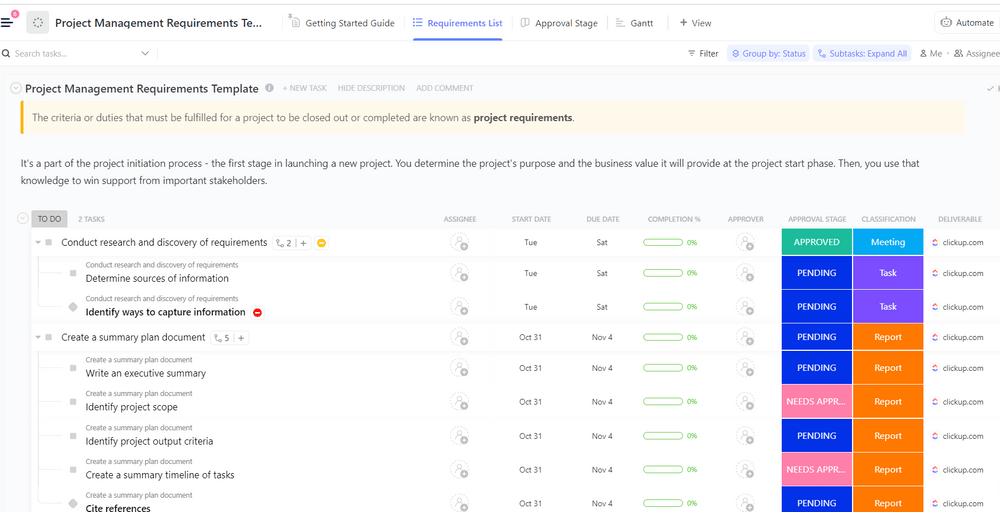
ابدأ عملية تحديد متطلبات المشروع باستخدام قائمة ClickUp
ما هي متطلبات المشروع؟
متطلبات المشروع هي المعايير أو العوامل أو الشروط المحددة التي يحتاج المشروع إلى استيفائها لكي يكون ناجحاً. وتساعد المتطلبات فريق المشروع على فهم أهدافه والقيود التي يواجهها والقيود التي يعاني منها وما يريد تحقيقه.
كما أنها تتأكد أيضًا من أن جميع المشاركين في المشروع يعرفون ما هو متوقع وأن المشروع يبقى على المسار الصحيح. تغطي المتطلبات أشياء مثل ما يجب القيام به ومتى يجب القيام به ومقدار تكلفته.
من خلال تتبع المتطلبات والتحقق بانتظام من أن يتم الوفاء بالمعالم الرئيسية ، يمكن لمديري المشاريع تقليل المخاطر، واتخاذ خيارات جيدة، والحفاظ على التركيز على الوفاء بالمواعيد النهائية!
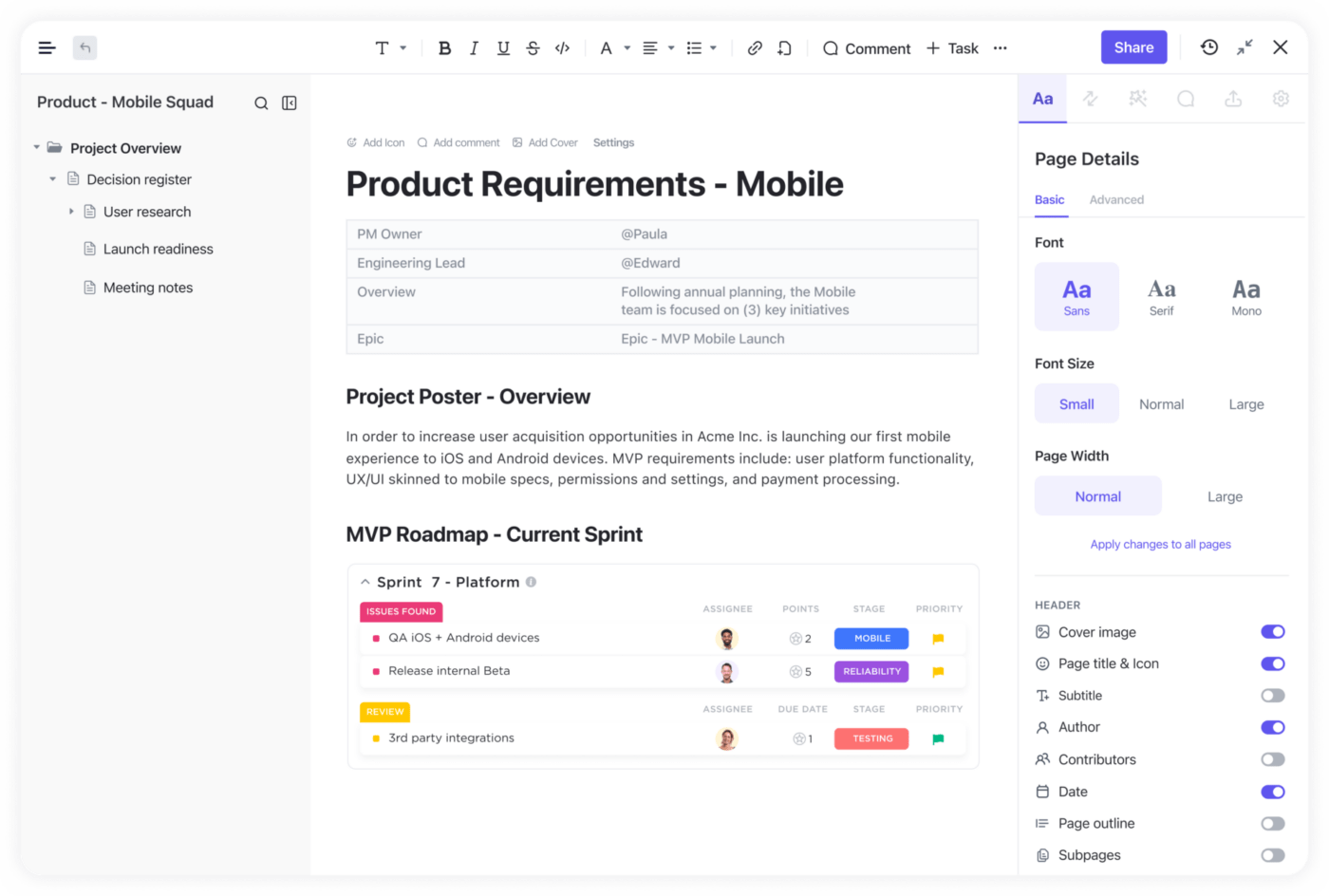
اعرض متطلبات منتجك مع أعضاء الفريق المعينين باستخدام طريقة عرض القائمة المضمنة في ClickUp
لمعرفة المزيد عن تخطيط إدارة المتطلبات !
لماذا يعتبر جمع متطلبات المشروع مهمًا؟
يعد فهم وجمع متطلبات المشروع عملية حيوية في إدارة المشروع. فهو يضمن وجود توافق وفهم بين جميع الأطراف المشاركة في المشروع، من أعضاء الفريق إلى أصحاب المصلحة والمستخدمين النهائيين.
تحدد هذه الرؤية المشتركة، التي يتم التوصل إليها من خلال عملية شفافة، توقعات واضحة وتشكل جانبًا أساسيًا للتخطيط الفعال للمشروع وتنفيذه والتحكم فيه. يساعد جمع المتطلبات في إنشاء متطلبات واقعية خطط المشروع, الجداول الزمنية والميزانيات، ويوجه القرارات المتعلقة بتخصيص الموارد وتخصيص المهام وجدولة المشروع.
وهو بمثابة معيار لقياس التقدم المحرز في المشروع ويحدد أهدافًا ملموسة وقابلة للتحديد لكي يسعى الفريق لتحقيقها. وهو أيضًا إجراء استباقي يساعد على تحديد المشكلات والمخاطر المحتملة والتخفيف من حدتها في وقت مبكر من مرحلة التخطيط. يقلل هذا النهج الاستباقي من احتمال حدوث مفاجآت غير سارة في وقت لاحق, الحد من التأخير في المشروع أو تجاوزات التكلفة المحتملة.
الأنواع المختلفة لوثائق متطلبات المشروع
يتوقف كل مشروع ناجح على فهم متين لمتطلباته. تضع متطلبات المشروع الأساس لتخطيط المشروع وتنفيذه ونجاحه في نهاية المطاف. سوف نتعمق في الأنواع الأربعة المتميزة من متطلبات المشروع لمديري المشاريع و يحتاج أصحاب المصلحة إلى مواءمة قبل بدء أي عمل.
المتطلبات الوظيفية
تصف المتطلبات الوظيفية الوظائف والإجراءات والسلوكيات المحددة التي يجب أن يتصف بها المنتج أو الخدمة النهائية للمشروع. غالبًا ما يتم التعبير عن المتطلبات الوظيفية بعبارات واضحة وقابلة للقياس. لا مجال للغموض! هذه المتطلبات حيوية لأنها تشكل الأساس لتصميم وتطوير واختبار الميزات الأساسية للمشروع.
ومن أمثلة المتطلبات الوظيفية ما يلي:
- مصادقة المستخدم: يجب أن يسمح النظام للمستخدمين بتسجيل الدخول بأمان باستخدام اسم مستخدم وكلمة مرور
- معالجة الدفع: يجب على التطبيق معالجة معاملات بطاقات الائتمان وإنشاء إيصالات الدفع
- التحقق من صحة إدخال البيانات: يجب أن يفرض النظام قواعد التحقق من صحة البيانات للحصول على معلومات دقيقة ومتسقة
المتطلبات غير الوظيفية
تركز المتطلبات غير الوظيفية على سمات الجودة وخصائص المنتج أو الخدمة النهائية للمشروع. وعلى عكس المتطلبات الوظيفية، فهي لا تصف إجراءات أو وظائف محددة. وبدلاً من ذلك، تضع المتطلبات غير الوظيفية معايير لتقييم الأداء العام للمشروع وأمنه وسهولة استخدامه وقابليته للتطوير.
وهي ضرورية لتلبية أصحاب المصلحة في المشروع التوقعات وضمان نجاح المشروع بما يتجاوز وظائفه الأساسية. ومن أمثلة المتطلبات غير الوظيفية ما يلي:
- الأداء: يجب أن يستجيب التطبيق لطلبات المستخدم في غضون ثانيتين لـ 90% من التفاعلات
- الأمان: يجب أن يتوافق النظام مع معايير الصناعة لحماية البيانات وتشفيرها
- سهولة الاستخدام: يجب أن تكون واجهة المستخدم بديهية وسهلة الاستخدام للأفراد ذوي الإعاقة

إدارة تقييم المتطلبات وقياس التقدم المحرز والإجراءات التصحيحية في ClickUp
المتطلبات الفنية
تغطي المتطلبات التقنية الجوانب التقنية للمشروع، وتشمل الأجهزة والبرمجيات والمنصات والتقنيات اللازمة لتنفيذ المشروع بنجاح. توفر هذه المتطلبات التوجيه لفريق التطوير، وتتوافق مجموعة التقنيات المختارة مع أهداف المشروع.
إن فهم المتطلبات التقنية أمر بالغ الأهمية لتأمين حل متكامل ومتوافق بشكل جيد. ومن أمثلة المتطلبات التقنية ما يلي:
- توافق نظام التشغيل: _يجب أن يكون التطبيق متوافقًا مع أنظمة تشغيل ويندوز وماك ولينكس
- نظام إدارة قاعدة البيانات: سيستخدم المشروع Oracle كنظام أساسي لإدارة قواعد البيانات.
- لغات البرمجة: سيتم تطوير النظام باستخدام لغة بايثون وجافا سكريبت
متطلبات العمل
تحدد متطلبات العمل الأهداف والنتائج رفيعة المستوى التي يهدف المشروع إلى تحقيقها من منظور العمل. فهي توفر سياقًا أوسع للمشروع وتوائم بينه وبين الأهداف التنظيمية. يعد فهم متطلبات العمل أمرًا أساسيًا لمديري المشاريع لإثبات أن المشروع يقدم قيمة ملموسة ويلبي احتياجات القيادة.
ومن الأمثلة على متطلبات العمل ما يلي:
- زيادة الحصة السوقية: يجب أن يساهم المشروع في زيادة الحصة السوقية بنسبة 10% في غضون ستة أشهر من إطلاقه
- خفض التكلفة: يجب أن يقلل التطبيق من التكاليف التشغيلية من خلال أتمتة العمليات اليدوية
- رضا العملاء: يجب أن يعزز المنتج النهائي للمشروع من رضا العملاء من خلال تبسيط خدمات الدعم

أضف متطلبات أصحاب المصلحة إلى ما هو مناسب مراحل المشروع على لوحة السحب والإفلات ClickUp Board
كيفية كتابة وتوثيق متطلبات المشروع
الخطوة 1: تحديد نطاق المشروع وأهدافه
تتمثل الخطوة الأولى في تحديد المتطلبات في إنشاء مستند المشروع الذي يحدد الخطوط العريضة ل نطاق وأهداف مشروعك . سيساعدك هذا على تحديد حدود ما يجب أن ينجزه المشروع، بالإضافة إلى توفير خارطة طريق لكيفية الوصول إلى هناك. تأكد من تضمين أسماء أصحاب المصلحة المعنيين بالمشروع لكل وظيفة أو فريق حتى يكون الجميع على نفس الصفحة بشأن الملكية.
تحقق من المزيد من الأساسيات وثائق المشروع !
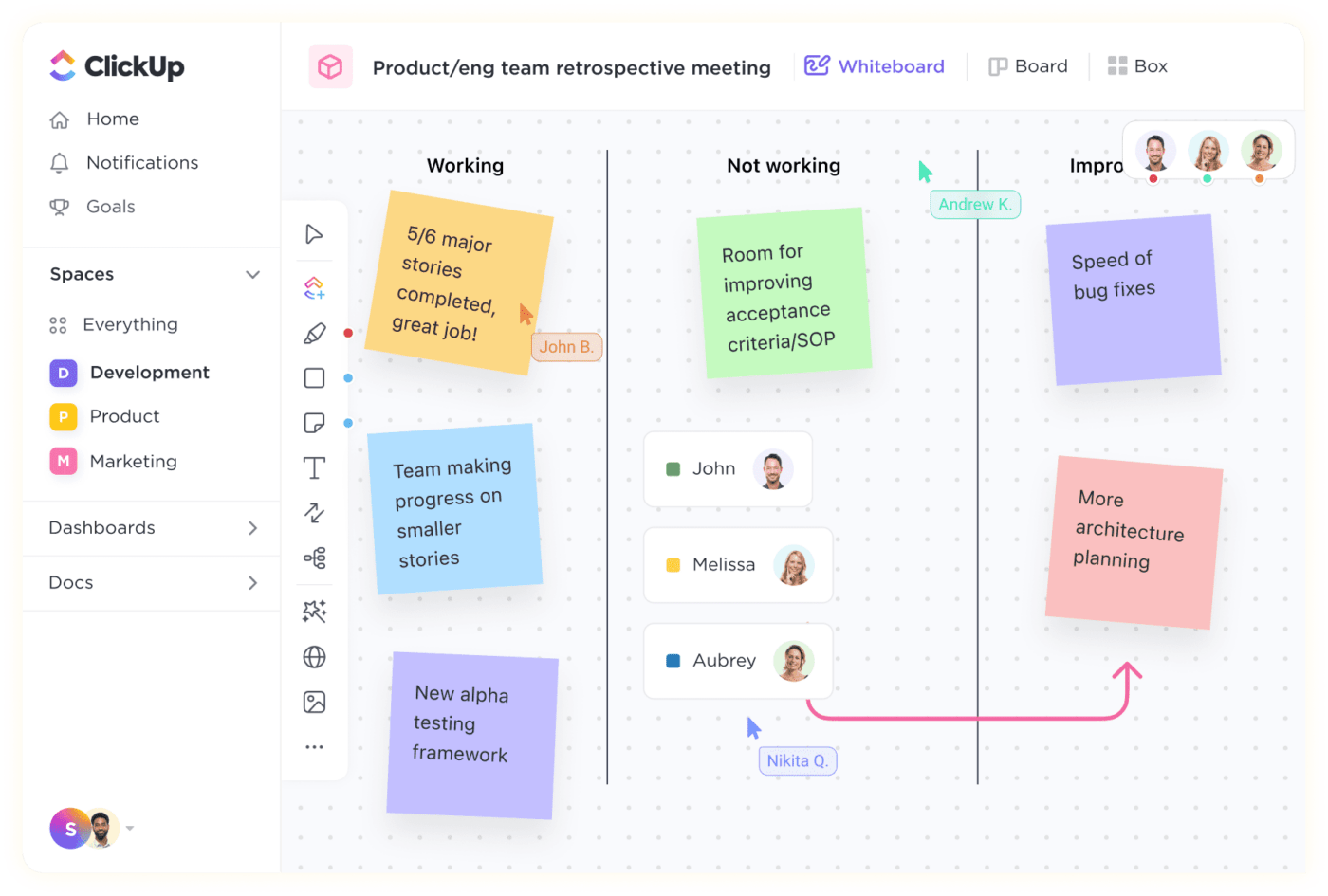
قم بالعصف الذهني والتخطيط ووضع الاستراتيجيات وتبسيط الاتصالات في الوقت الفعلي لشحن المشاريع بشكل أسرع باستخدام لوحات ClickUp Whiteboards
الخطوة 2: جمع متطلبات العمل وأصحاب المصلحة
بمجرد تحديد النطاق والأهداف، حان الوقت للانتقال إلى استنباط المتطلبات. تتضمن هذه العملية إشراك أصحاب المصلحة الرئيسيين لجمع المتطلبات والسياق والخبرة حول ما يجب تضمينه في المشروع المخرجات .
خلال هذه الجلسات، اطرح أسئلة تساعدك على تحديد المتطلبات الوظيفية وغير الوظيفية لمشروعك. تأكد من توثيق النتائج التي توصلت إليها، حيث سيساعدك ذلك على إنشاء مجموعة شاملة من المتطلبات الواضحة!
مكافأة:_
_/مرجع/ https://clickup.com/blog/requirements-management-tools// أدوات إدارة المتطلبات* %/%href/_
!
الخطوة 3: توثيق المتطلبات
بمجرد جمع كل المتطلبات، من المهم إنشاء وثيقة واحدة تحدد جميع المتطلبات. يجب ألا تتضمن هذه الوثيقة المتطلبات الوظيفية وغير الوظيفية ومتطلبات المستخدم فحسب، بل يجب أن تتضمن أيضًا أي قيود أو افتراضات تم وضعها أثناء العملية.
المكافأة: أضف جدولاً زمنياً وميزانية تقديرية للمشروع بناءً على المتطلبات التي تم جمعها. سيساعدك هذا على وضع خطة واقعية للتنفيذ!
الخطوة 4: مراجعة المتطلبات والتحقق من صحتها
بمجرد توثيق متطلبات المشروع، من المهم مراجعتها مع أصحاب المصلحة الرئيسيين والتحقق من دقتها. يجب أن تتضمن هذه العملية مراجعة أي افتراضات تم وضعها خلال ورش عمل استنباط المتطلبات، بالإضافة إلى التحقق من صحة أي قيود قد تكون تم تحديدها.
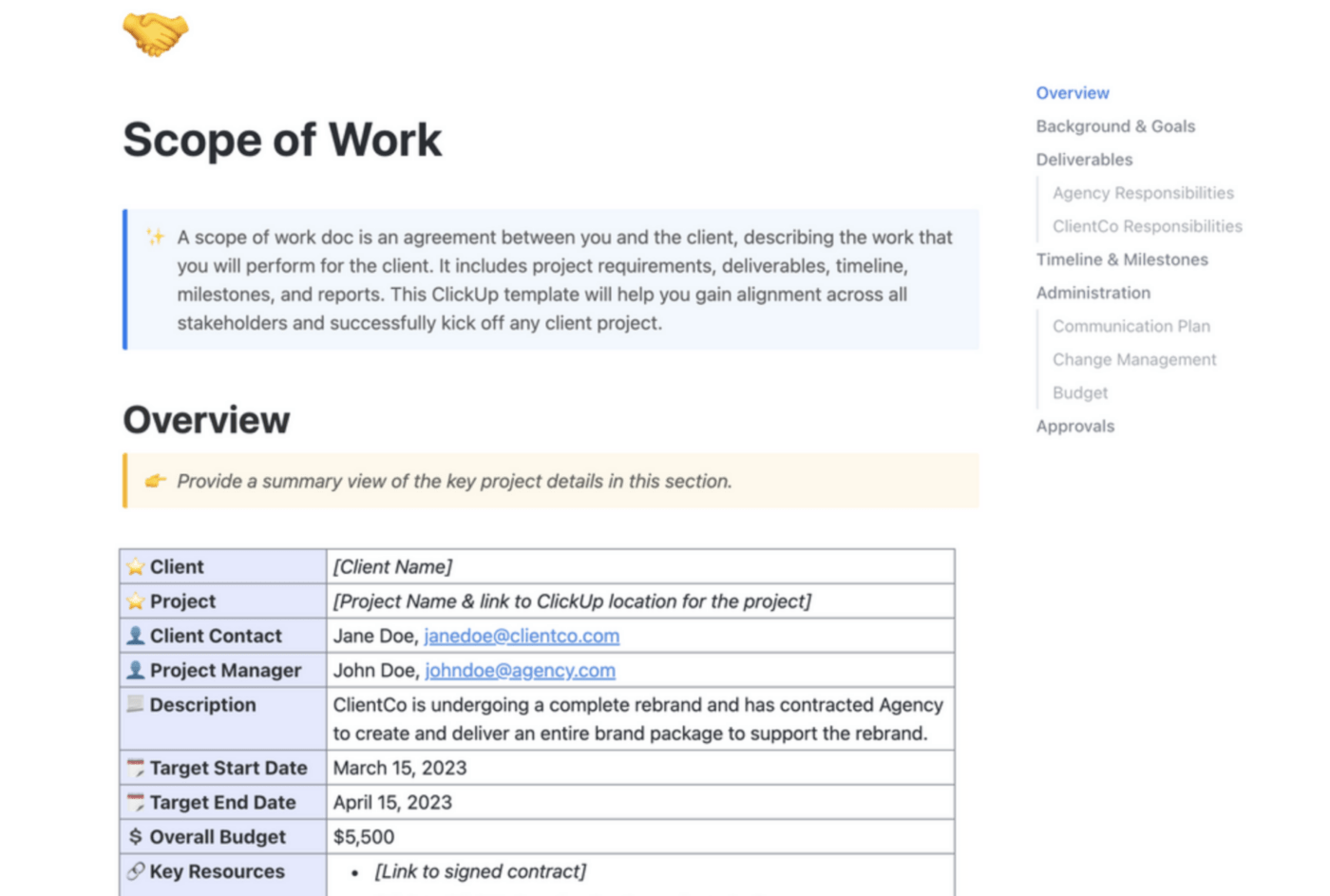
استخدم مستندات ClickUp Docs لتوثيق متطلبات المشروع ونطاق المشروع في مكان واحد
هذه أيضًا فرصة لمناقشة كيفية تأثير التغييرات في المتطلبات على جوانب أخرى من المشروع. بمجرد أن يتفق جميع أصحاب المصلحة على المتطلبات، يمكن وضع اللمسات الأخيرة على الوثيقة ومشاركتها مع المجموعة الجماعية!
الخطوة 5: مراقبة ومراقبة المتطلبات
ستكون مراقبة متطلبات المشروع والتحكم فيها جزءًا من عبء العمل اليومي لدعم فريق المشروع. من خلال مراقبة المتطلبات عن كثب، يمكن لمديري المشاريع تقييم زحف النطاق وإجراء تعديلات للحفاظ على تركيز المشروع. وهذا يقلل من تأثير ذلك على الجدول الزمني للمشروع وتكاليفه واستقراره بشكل عام.
للتحكم بفعالية في متطلبات المشروع، سيوفر لك تنفيذ عملية رسمية للتحكم في التغيير الوقت. تقوم هذه العملية بتقييم تغييرات المتطلبات والموافقة عليها لتتماشى مع أهداف المشروع.
استخدام مصفوفة تتبع المتطلبات روابط (RTM) مخرجات المشروع لمتطلبات محددة، مما يوفر رؤية واضحة للتقدم المحرز. (المزيد عن هذا لاحقًا!)
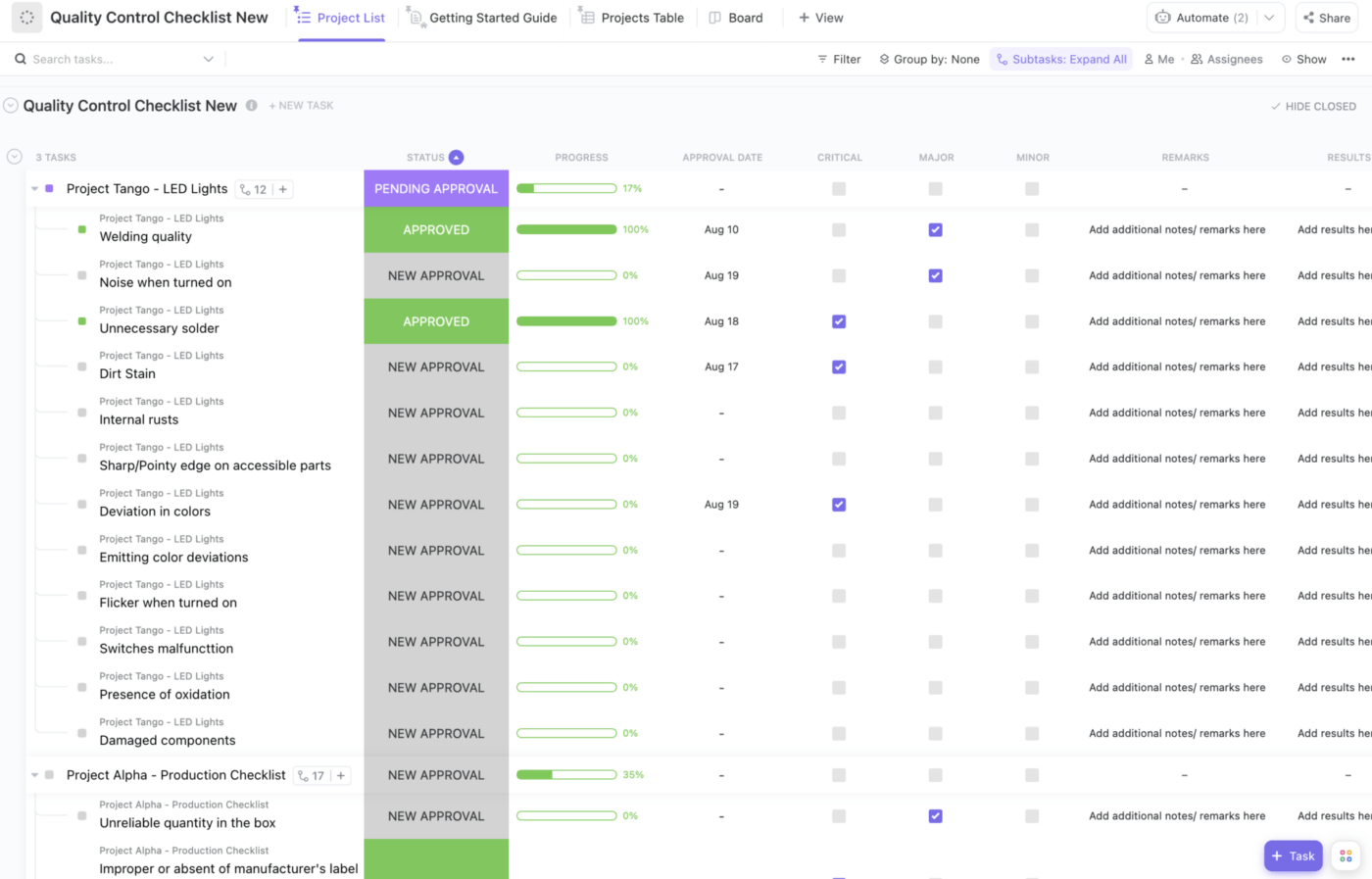
أرسل إلى فريق إدارة المشروع قائمة مراقبة الجودة في ClickUp
5 استراتيجيات لإدارة متطلبات المشروع ## 5 استراتيجيات لإدارة متطلبات المشروع
ستكون الخطة المفصلة والمنظمة بشكل جيد مصدر الحقيقة لإدارة متطلبات المشروع وتحقيق الأهداف المرجوة. إليك خمس استراتيجيات ستساعدك على إدارة متطلبات مشروعك بفعالية!
1. احصل على نظرة ثاقبة من قادة المشروع
يعد تحديد أولويات المتطلبات التي تم جمعها مهمة غير قابلة للتفاوض لفريق المشروع. تحقق هذه العملية المواءمة بين جميع أصحاب المصلحة حول متطلبات المشروع الأهداف والغايات ويبقي المشروع على المسار الصحيح.
يعد فهم العلاقات بين المتطلبات وتحديد أكثرها أهمية لنجاح المشروع من العناصر الرئيسية لتحديد الأولويات الفعالة. من خلال تحديد أولويات واضحة، يمكن للفريق التركيز على تنفيذ أهم الميزات والوظائف الأساسية، وتعظيم تأثير المشروع، وتقديم القيمة لأصحاب المصلحة.
والأهم من ذلك أنه يغطي أي تبعيات يجب أن تكون على دراية بها. ستتمكن من إنشاء تسلسل منطقي للأنشطة بحيث تكتمل إحدى المهام قبل أن تبدأ مهمة أخرى. وهذا يمنع أوجه القصور ويتجنب التأخيرات الناجمة عن المهام التي يتم إنجازها خارج الترتيب!
2. إجراء ورش عمل لاستنباط المتطلبات
ورش عمل استنباط المتطلبات هي في الأساس جلسات عصف ذهني لمناقشة متطلبات المشروع. يشارك في ورش العمل هذه أصحاب المصلحة من الأقسام ذات الصلة مثل التطوير والتسويق والمبيعات وتكنولوجيا المعلومات، الذين يجتمعون معًا لتبادل الأفكار وصقلها إلى متطلبات ملموسة للمشروع. خلال هذه الجلسات، يمكن استخدام أدوات مثل الخرائط الذهنية أو اللوحات البيضاء الرقمية للتعاون في الوقت الفعلي أو بشكل غير متزامن.

تحويل الأفكار إلى مهام على ClickUp الخريطة الذهنية لأعضاء فريق المشروع
بمجرد تقييم جميع المتطلبات وتحديد أولوياتها، يمكن لفريق المشروع الانتقال إلى وضع خطة المشروع التفصيلية. وسيشمل ذلك الجدول الزمني والميزانية, تخصيص الموارد وأي موارد أخرى مطلوبة لإنجاز المشروع بنجاح.
ارجع إلى الخريطة الذهنية أو السبورة من ورشة العمل واستمر في سحب المعلومات حسب الحاجة!
3. اتبع عملية إدارة المشاريع الرشيقة
في مشهد الأعمال اليوم سريع الوتيرة وسريع التطور، أصبحت إدارة المشاريع الرشيقة نهجًا حاسمًا لإنجاز المشاريع بنجاح. صُممت المنهجيات الرشيقة للتكيف مع التغيير، وتعزيز التعاون، وإعطاء الأولوية لاحتياجات العملاء، مما يجعلها مناسبة تمامًا لمعالجة تعقيدات المشاريع الحديثة.
تتفوق الإدارة الرشيقة للمشاريع في التكيف مع التغيير، وإعطاء الأولوية لاحتياجات العملاء، وتعزيز التعاون، وتسريع الوقت اللازم للوصول إلى السوق، وتعزيز التحسين المستمر .
عند إعداد نظام رشيق لإدارة المتطلبات، من المهم مراعاة ما يلي:
- تحديد الأدوار والمسؤوليات لكل صاحب مصلحة
- وضع مجموعة من المعايير لتحديد متى يجب أو لا يجب إجراء تغييرات على المتطلبات
- تحديد عملية واضحة لإدارة التغييرات على متطلبات المشروع
- إنشاء آليات إبلاغ تسمح لأصحاب المصلحة بتتبع التقدم المحرز ومعالجة المشاكل المحتملة
- قم بإعداد قنوات اتصال بين أصحاب المصلحة بحيث يتم إخطار الجميع بأي تغييرات أو تحديثات

إنشاء الكمال سير العمل الرشيق وبناء نظام كانبان مرن باستخدام طريقة عرض اللوحة في ClickUp
4. تطبيق عملية التحكم في التغيير
يعد بناء عملية قوية للتحكم في التغيير أمرًا ضروريًا لإدارة التغييرات التي تطرأ على متطلبات المشروع وضمان تقييمها والموافقة عليها وتنفيذها بشكل صحيح.
إليك دليل سريع خطوة بخطوة لإنشاء عملية فعالة للتحكم في التغيير!
تحديد فئات التغيير: حدد أنواعًا مختلفة من التغييرات التي قد تحدث أثناء المشروع، مثل تغييرات النطاق أو تعديلات المتطلبات أو تعديلات الجدول الزمني أو إعادة تخصيص الموارد. يساعد تصنيف التغييرات في فهم تأثيرها وتحديد مستويات الموافقة المناسبة.
صياغة إجراءات طلب التغيير: وضع إجراءات واضحة لتقديم طلبات التغيير. تحديد الشكل المطلوب والوثائق والمعلومات التي يجب على أصحاب المصلحة تضمينها في طلبات التغيير الخاصة بهم. وهذا يتحقق من أن طلبات التغيير منظمة بشكل جيد وتتضمن جميع التفاصيل اللازمة للتقييم.
إجراء تقييم للتغيير وتحليل الأثر: وضع معايير لتقييم طلبات التغيير. حدد من سيكون مسؤولاً عن تقييم التغييرات المقترحة وإجراء تحليل للأثر. يجب أن يأخذ هذا التحليل في الاعتبار عوامل مثل الجدول الزمني للمشروع والميزانية وتوافر الموارد والمخاطر المحتملة.
تصميم عملية الموافقة والمراجعة: تعيين سلطة موافقة أو مجلس مراقبة التغيير مسؤول عن مراجعة طلبات التغيير والموافقة عليها أو رفضها. قم بإعداد جدول زمني للمراجعة المنتظمة لتقييم طلبات التغيير على الفور، مما يمنع التأخير في تنفيذ المشروع.
تنفيذ خطة تواصل: إبلاغ جميع أصحاب المصلحة المعنيين بطلبات التغيير والتقييمات والقرارات. الاحتفاظ بتوثيق مفصل لكل طلب تغيير وعملية التقييم والقرار النهائي لإضفاء الشفافية والمساءلة الكاملة.
إضافة التغييرات المعتمدة: بمجرد الموافقة على طلب التغيير، قم بدمج التغييرات في خطة المشروع وإبلاغ فريق المشروع وأصحاب المصلحة الآخرين بالتحديثات. تتبع التقدم المحرز في التنفيذ لمعرفة ما إذا كانت التغييرات قد تم تنفيذها بشكل مناسب.
رصد وقياس الأثر: راقب باستمرار تأثير التغييرات المعتمدة على تقدم المشروع وميزانيته ونطاقه. مراجعة فعالية عملية التحكم في التغيير نفسها بانتظام لتحديد مجالات التحسين.
5. استخدام مصفوفة تتبع المتطلبات (RTM)
تجمع مصفوفة تتبع المتطلبات (RTM) جميع الاستراتيجيات التي قمنا بتغطيتها معًا تحت سقف رقمي واحد. والغرض منها هو إنشاء رابط واضح بين متطلبات المشروع ومخرجات المشروع والحفاظ عليه. إليك كيفية استخدام مصفوفة تتبع المتطلبات:
- تحديد المتطلبات: ابدأ بإدراج جميع متطلبات المشروع في العمود الأول من المصفوفة
- تعيين النواتج القابلة للتسليم: في الأعمدة التالية، قم بتعيين كل متطلب في كل عمود من الأعمدة التالية إلى نواتج المشروع المقابلة، مثل وثائق التصميم ووحدات التعليمات البرمجية وحالات الاختبار وأدلة المستخدم. وهذا ينشئ علاقة مباشرة بين ما يجب تسليمه والمتطلبات التي تقود تلك المخرجات
- التحقق والتحقق من الصحة: أثناء تنفيذ المشروع، تساعد آلية التحقق والتحقق من الصحة في ضمان تلبية كل متطلب من المتطلبات. عند اكتمال كل ناتج قابل للتسليم، قم بالتحقق والتحقق من أنه يفي بالمتطلبات المرتبطة المدرجة في نموذج تقييم النتائج
- تحليل التأثير: عندما تكون هناك تغييرات في المتطلبات أو نطاق المشروع، استخدم نموذج تقييم الأداء لإجراء تحليل الأثر. تحديد النواتج التي تتأثر بالتغييرات وتقييم آثارها على الجدول الزمني للمشروع وموارده
- التحكم في النطاق: تساعد نشرة المتطلبات في التحكم في النطاق من خلال توفير فهم واضح لتغطية المتطلبات. وينبغي إضافة أي متطلبات جديدة إلى المصفوفة، ويجب على الفريق التحقق من تحديد جميع المخرجات ذات الصلة ومعالجتها
- قناة الاتصال: تعزّز مصفوفة RTMالشفافية بين أصحاب المصلحة في المشروع. ويوفر رؤية شاملة لكيفية مساهمة كل متطلب في نواتج المشروع، مما يسهل توصيل التقدم المحرز والحالة إلى أصحاب المصلحة
- وثائق المشروع: تُعدّ إدارة السجلات والمحفوظات جزءًا مهمًا من وثائق المشروع. فهي تساعد في عمليات تدقيق الامتثال والتدقيق التنظيمي من خلال إظهار المواءمة بين المتطلبات والمنتج الذي تم تسليمه
ابدأ مع قالب مصفوفة التتبع ClickUp !

إدارة متطلبات مشروعك في العصر الرقمي
تُعد كتابة متطلبات المشروع ركيزة أساسية لإعداد هيئة إدارة المشروع بأكملها لنجاح أي مشروع. تُعد المتطلبات المحددة والمنظمة بشكل جيد بمثابة المخطط الذي يوجه دورة حياة المشروع بأكملها، بدءًا من التخطيط والتنفيذ وحتى المراقبة والتحكم.
من خلال استثمار الوقت والجهد في عملية جمع المتطلبات، يمكن لمديري المشروع وأصحاب المصلحة وضع توقعات واضحة وتخفيف المخاطر ومواءمة جميع أعضاء الفريق نحو هدف مشترك!
